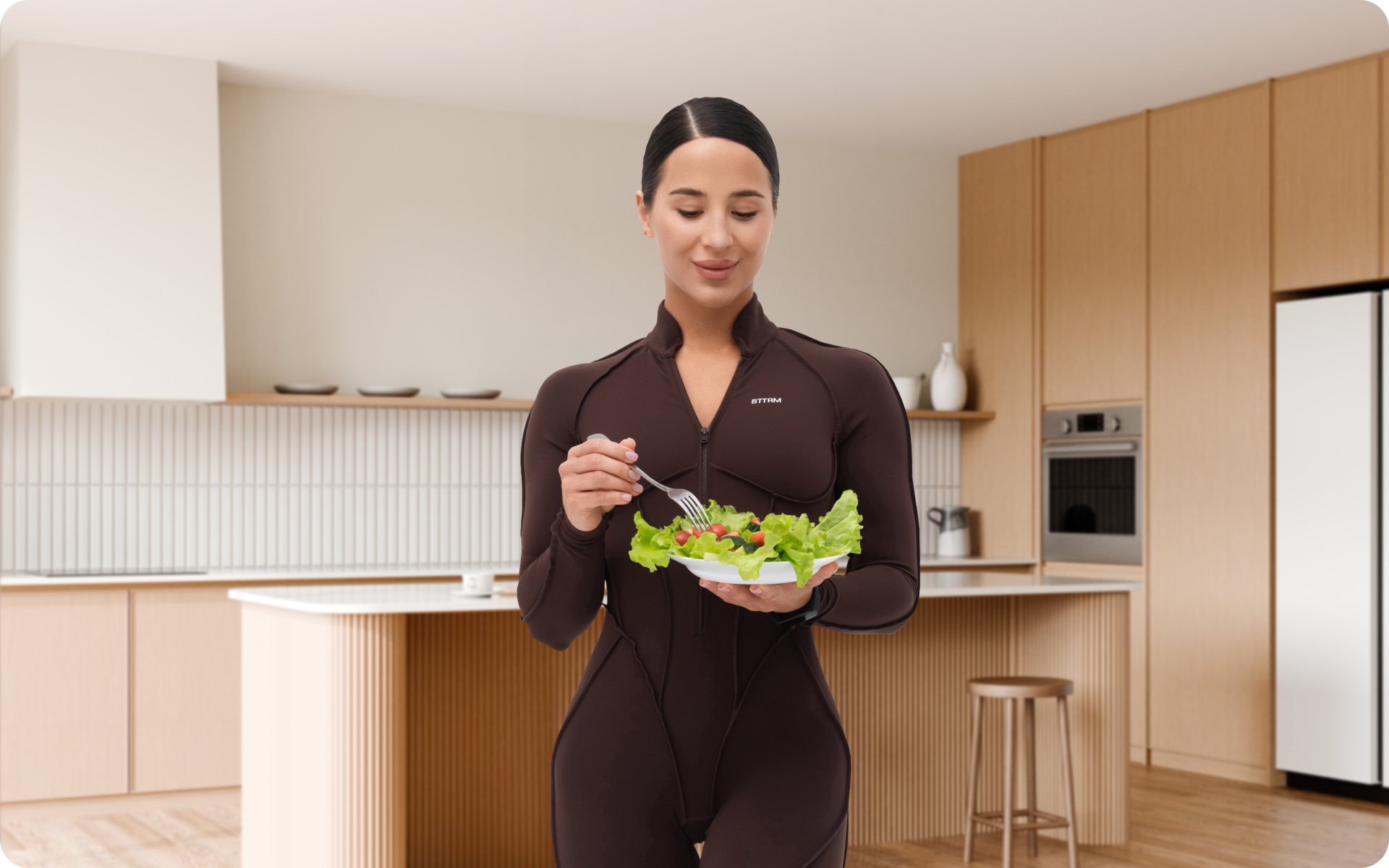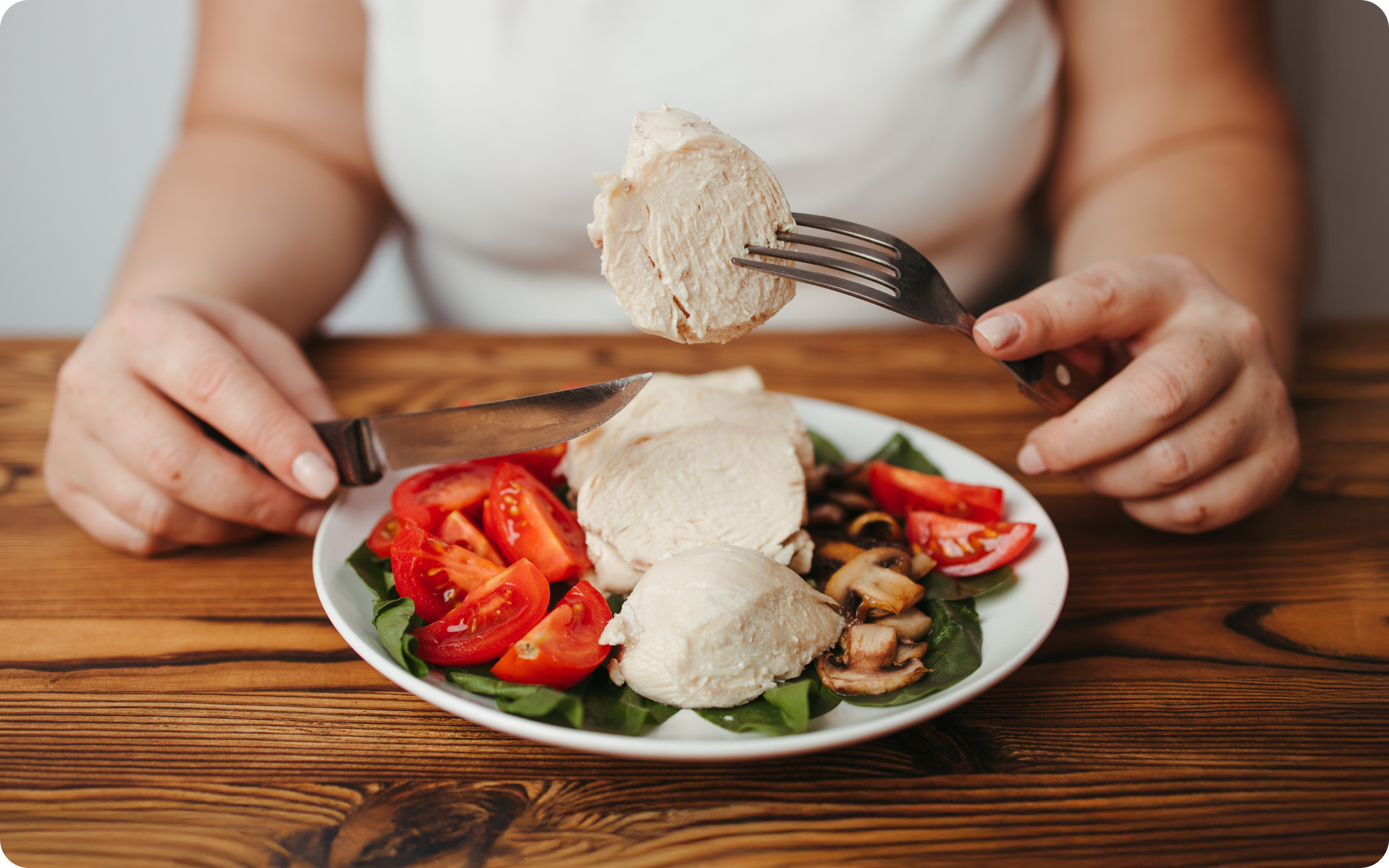The 1,000-calorie diet plan is a restrictive diet that allows you to cut down your calorie intake to a bare minimum of just 1,000 a day while consuming low carbs, high fat, and moderate to high proteins.
Before we jump into meal planning, recipes, and cooking tips, let’s first understand the logic behind the keto diet 1,000-calorie meal plan, the safety concerns, and expected results.
Should You Go on a 1,000-Calorie Keto Diet?
We can’t answer that for you. Scientifically, we all have different basal metabolic rates (BMRs) due to body composition, age, sex, and other factors. Therefore, we can’t claim that 1,000 calories is the magic number for everyone. 1,000 calories is actually very low for most people. However, the 1,000-calorie keto diet is likely to help you create a calorie deficit, which will help you lose weight.
Let’s explain this further.
Your body needs calories/energy to support your daily energy needs. These energy expenses can be resting energy where your body requires energy for bodily activities such as blood circulation, thermic energy for food digestion, metabolism and absorption, and activity energy you need for exercise or other physical activities.
Depending on your BMR and activity level, you may require a total calorie count of 2,000 calories to support all these energy expenses. But if you’re looking to lose weight, you need to create a calorie deficit where you reduce the number of calories you consume to force your body to burn the energy you already have stored in your body.
Studies have suggested that an average male requires 2,500 calories and an average female requires 2,000 calories a day to support their energy needs (1). At the same time, studies have also suggested that a deduction of 500 to 1,000 calories a day from your meal plan can result in a weight loss of one to two pounds (0.5-1 kg) a week (2).
Therefore, for the 1,000-calorie keto diet plan to be effective as a weight-loss strategy, you need to aim to create a calorie deficit, which will hopefully result in weight loss.
Is it Safe to Go on a 1,000-Calorie Keto Diet?
A 1,000-calorie diet plan isn’t safe for everyone. Consuming too little food can lead to malnutrition and other adverse effects. While some people can live off 1,000 or even 800 calories a day, it’s important that you calculate your calorie count before you start this diet plan to ensure you don’t deprive your body of too much energy.
It’s also essential that you consult your healthcare provider before starting this or any other very low-calorie diet plan. Eating so few calories isn’t safe for everyone and often requires medical supervision.
Note that you can choose to have different meal frequencies from three meals a day to even five to six small meals a day, but we would recommend a three-meals-a-day diet as you will eat more satisfying meals.
How to Calculate Your Calorie Deficit
Your calorie deficit is the difference between the number of calories you burn in a day and the number you take in through food. This difference is usually recommended to be 500-1,000 calories for weight loss. To calculate your calorie goal, start by calculating your maintenance calorie needs, then subtract 500-1,000 from that or whichever number you deem fit for your needs. You can use a calorie calculator from the BetterMe app or use the Harris-Benedict equation that is often used by professionals.
Using the equation, you start by calculating your BMR, then multiply the result with your activity factor:
Adult male – 66 + (6.3 x body weight in lb) + (12.9 x height in inches) – (6.8 x age in years) = BMR
Adult female – 655 + (4.3 x weight in lb) + (4.7 x height in inches) – (4.7 x age in years) = BMR
Once you’ve acquired your BMR, use it in the following equation (based on your activity levels):
Sedentary – little or no exercise = BMR x 1.2
Minimally active – one to three days per week of exercise or activity = BMR x 1.375
Moderately active – three to five days per week of moderate activity or sports = BMR x 1.55
Very active – six to seven days per week of strenuous exercise = BMR x 1.725
Extra active – athletes who train even twice per day = BMR x 1.9
The result you achieve from this calculation is your daily energy needs to maintain your weight. If your aim is to lose weight, you now need to subtract 500-1,000 a day, which will give you your calorie intake target.
What Is the Keto Macro for 1,000 Calories?
To determine the keto macro for a 1,000-calorie diet, you’ll need to follow the typical ketogenic macronutrient ratio, which is approximately 70-75% fat, 20-25% protein, and 5-10% carbohydrates (3). Here’s a breakdown:
- Fat: 70-75% of 1,000 calories = 700-750 calories from fat, which is approximately 78-83 grams of fat (as fat has 9 calories per gram).
- Protein: 20-25% of 1,000 calories = 200-250 calories from protein, which is approximately 50-63 grams of protein (as protein has 4 calories per gram).
- Carbohydrates: 5-10% of 1,000 calories = 50-100 calories from carbs, which is approximately 13-25 grams of carbohydrates (as carbs have 4 calories per gram).
These ratios can be adjusted slightly based on individual dietary needs and goals.
Simple 1,000-Calorie Keto Diet Plans
Here are sample 1,000-calorie keto diet plans for four days, including breakfast, lunch, and dinner, all with recipes and calorie information.
Day One (975 Calories)
For our first meal plan, we’ll include tasty eggs cooked with basil for breakfast, turkey wrapped in lettuce for lunch, and cured pork also wrapped in red leaf lettuce for dinner.
Breakfast – Pesto Scrambled Eggs (276 Calories)
This typical keto breakfast for a 1,000-calorie diet features 21% protein, 76% fat, and only 3 grams of carbs.
Ingredients
- 1/2 tablespoon/ 7.1 grams of salted butter
- 2 whole eggs – 100 grams
- 100 grams of basil pesto
- Salt and black pepper to taste
Method
- Melt the butter in a skillet over medium heat.
- Break the eggs directly into the pan and start to scramble using a heat-resistant spatula.
- As you scramble, add the pesto and continue scrambling as you work it in gently.
- Once the eggs are no longer runny, turn off the heat source and serve.
Read more: Vegan Keto Diet: Exploring a Plant-Based Approach to Low-Carb Living
Lunch – Turkey Lettuce Roll-Ups (290 Calories)
The meal features 14% carbs, 65% protein, and 21% fat.
Ingredients
- 2 green leaves of lettuce
- 48 grams of sliced and cooked turkey meat
- 2 peppers
- A dash of salt and black pepper
Method
- Lay down the lettuce and top with the turkey.
- Sprinkle the pepper over the turkey and add the salt and pepper.
- Wrap the lettuce leaf.
You can add slices of cheese (approximately 50 grams of it) for an additional 14 grams of protein and 19g of fat.
Dinner – BLT Lettuce Wraps with Eggs (409 Calories)
Dinner contains net carbs of six grams, 23 grams of fat, and 8 grams of protein. This translates to 12% protein and 79% fat.
Ingredients
- 4 strips of cured pork
- 1 whole ripe tomato
- 15 grams/ one tablespoon of light mayonnaise
- 3 red lettuce leaves
- A dash of black pepper and salt
- 2 large eggs
Method
- Chop and cook the bacon. At the same time, place a pot of water to boil and add the two eggs.
- Shred about a third of the lettuce and dice the tomato.
- In a bowl, combine the tomato, pepper, and mayonnaise.
- Remove the eggs from heat and place them in another bowl with cold water. Let the eggs sit in the cold water before you peel them.
- Lay out the lettuce leaves and add the shredded lettuce, tomato mixture, cooked bacon, and peeled eggs.
- Roll up and serve.
Day Two (997 Calories)
On the second day, we start with eggs again, then some chicken for lunch, followed by shrimp to wind up the day.
Breakfast – Spinach, Swiss, and Egg White Omelet (326 Calories)
Breakfast features 59% protein, 34% fat, and 3 grams of carbs.
Ingredients
- 4 strips of bacon
- 2 teaspoons of cooking oil
- 1 cup of raw spinach spinach
- 3 egg whites
- 14 grams / half an ounce of Swiss cheese
Method
- Add the oil to a skillet and fry the bacon over medium to high heat until it’s brown and crispy
- In a non-stick pan, add another teaspoon of oil and sauté the spinach for approximately three to five minutes.
- In the same pan, add the lightly beaten egg whites and cook until opaque.
- Flip the egg over and top with Swiss cheese.
- Remove from the pan and serve with the crispy bacon over the omelet.
Lunch – Baked Honey Mustard Chicken – (282 Calories)
This meal is highly nutritious with plenty of vitamins A and C, potassium, iron, and calcium. It features 39 grams of protein, 5 grams of fat, and 18 grams of carbs.
Ingredients
- 700 grams of boneless chicken breasts (skinless also)
- 1/4 cup of honey and mustard
- 1 tablespoon of chopped parsley, basil, smoked paprika, and lemon juice
- A pinch of salt and pepper to taste
Method
- Preheat your oven to 375 ° Fahrenheit
- Rinse and pat dry the chicken breasts before adding them to a large bowl.
- Season the chicken with salt, pepper, spices, and lemon juice. Coat each side of the chicken.
- Cook in the oven for 45 to 50 minutes, regularly turning and basting.
Dinner – Creamy Asparagus and Shrimp Alfredo (388 Calories)
Dinner contains 73% fat and 22% protein.
Ingredients
- 4 raw shrimps
- 1/2 tablespoon/7 grams of unsalted butter
- 1/2 cup of asparagus
- 1/4 cup of heavy whipping cream
- 1/16 cup of grated parmesan cheese
- A dash of salt and pepper
Method
- Peel and devein the shrimp and season with salt and pepper.
- In a skillet, sauté the shrimp with butter over medium heat for two to three minutes.
- Add the asparagus and sauté for another two minutes.
- Add cream and cheese and reduce the heat to allow the cheese to melt gently as the sauce also thickens.
Read more: Keto Diet for Seniors: Separating Fact from Fiction
Day Three (997 Calories)
On the third day, we start light with a smoothie, have a hearty lunch, and finish light with a dinner with less than 100 calories.
Breakfast – Low-Carb Blueberry Smoothie (323 Calories)
This breakfast is easy peasy, lemon squeezy with only 10% carbs, 4% protein, and 86% fat.
Ingredients
- 1 1/3 cups of coconut milk
- 3 fresh blueberries
- 1 tablespoon of lemon juice
- ½ teaspoon of vanilla extract
Method
- Take all the ingredients and add them to a blender.
- Blend until the mixture is smooth.
- Serve.
Lunch – Keto Zucchini and Walnut Salad (582 Calories)
Lunch features a mix of smooth and textured ingredients adding up to 5% carbs, 6% protein, and 89% fat.
Ingredients
- 2 tablespoons of olive oil
- 3/4 cup of mayo
- 2 teaspoons of lemon juice
- 1 garlic clove
- 1/2 teaspoon of salt
- 1/4 teaspoon of black pepper and chili powder
- 1 head of romaine lettuce
- 4 ounces of arugula lettuce
- 1/4 cup of chives
- 2 zucchinis
- 1 cup of walnuts
Method
- In a bowl, make the dressing using the olive oil, mayo, and lemon juice, then set aside to allow the flavor to develop.
- Make the salad using the romaine lettuce, arugula lettuce, and chives.
- Prepare the zucchini by splitting them into halves crosswise and then cutting them into half-inch pieces. Make sure to remove all the seeds.
- Heat the olive oil over medium heat in a pan, add the zucchini pieces, season with salt and pepper, and sauté for two minutes.
- Add the onions to the salad.
- Roast the walnuts and season with salt and pepper, then add to the salad bowl.
- Mix all the salad ingredients as you drizzle the dressing over.
- Serve.
Reasons why BetterMe is a safe bet: a wide range of calorie-blasting workouts, finger-licking recipes, 24/7 support, challenges that’ll keep you on your best game, and that just scratches the surface! Start using our app and watch the magic happen.
Dinner – Chicken Paillards (92 Calories)
This dinner can also serve as a snack. With only 92 calories, the meal is pure protein to keep you full throughout the night.
Ingredients
- 4 skinless and boneless chicken breasts.
- 1/2 teaspoon of salt and black pepper
- 2 teaspoons of olive oil
Method
- Take the chicken breasts, wrap them in plastic film, and tenderize them using a meat mallet.
- Add salt and pepper to both sides of the chicken breast.
- In a large skillet, add the oil, and place over medium-high heat.
- Add the chicken and sauté for three minutes on each side.
- Turn off the heat and serve.
Day Four (959 Calories)
We start with some cauliflower hash browns on the fourth day, followed by lasagna for lunch, then meatloaf for dinner.
Breakfast – Keto Cauliflower Hash Browns (282 Calories)
For breakfast, we take hash browns to another level using cauliflower. This meal is 7% carbs, 10% protein, and 83% fat.
Ingredients
- 1 pound / 450 grams of cauliflower
- 3 large eggs
- 1/2 cup of grated onions
- A pinch of salt and black pepper
- 4 ounces of butter
Method
- Wash the cauliflower and grate using a grater or food processor, then place in a large bowl.
- Add the other ingredients to the cauliflower bowl and set it aside.
- Preheat the oven to a low heat.
- In a large skillet, melt the butter over medium heat. Scoop out a small section of the mixture, shape it into a pancake, and place it into the pan.
- Flatten the hash brown to about three or four inches in diameter and cook each side for approximately 5 minutes or until browned.
- Add to the oven for more browning for just 5 minutes.
- Remove from the oven and serve.
Lunch – Easy Protein Noodle Low-Carb Lasagna (415 Calories)
Low-carb lasagna is still as tasty as the original lasagna, filled with plenty of protein, cheese, onion, and marinara sauce. This Italian meal features 11% carbs, 27% protein, and 62 % fat.
Ingredients
- 2 tablespoons of olive oil
- 1/2 cup of chopped onions
- 2 garlic cloves
- 12 ounces of Italian sausage
- 12 ounces of ground beef
- 4 1/2 cups of marinara sauce (unsweetened)
- 2 cups of ricotta cheese
- 3 cups of mozzarella cheese
- 1 1/2 cups of shredded parmesan cheese
- 1/2 teaspoon of salt and black pepper
Method
- Preheat the oven to 425 ° Fahrenheit.
- Take a Dutch oven and place it over medium-high heat. Add the olive oil, onions, and garlic. Cook till the onions are translucent, and the garlic has fragrance.
- Add the sausage and ground beef and heat till the meat is cooked.
- Add the marinara sauce and allow it to simmer for 5-10 minutes over medium to low heat.
- In a bowl, add the ricotta cheese, egg, and salt, then combine.
- Take half of the meat sauce and add it to the bottom of the baking dish. Follow the layer with the ricotta mixture, mozzarella, and parmesan cheese.
- Repeat the layers.
- Cover with foil to prevent sticking and bake for 25 minutes.
Dinner – Pepper Jack Stuffed Turkey Zucchini Meatloaf (262 Calories)
Who doesn’t love a protein-packed meatloaf? The meatloaf has approximately 13 grams of carbs, 23 grams of protein, and 13 grams of fat.
Ingredients
- 1 pound of lean turkey meat
- 1 cup of diced onions
- 1 cup of shredded zucchini
- 2 garlic cloves
- 1 egg
- 1/2 cup of breadcrumbs
- 2 tablespoons of ketchup
- 1 teaspoon cumin, Dijon mustard, and oregano
- 1/2 teaspoon of garlic powder, cayenne pepper, black pepper, and salt
- 4 ounces of pepper jack cheese
- 1/2 cup of tomato sauce and honey
- 1 1/2 teaspoons of apple cider vinegar
- 1 tablespoon of mustard
- A dash of hot sauce and soy sauce
Method
- Preheat the oven to 375 ° Fahrenheit.
- In a bowl, combine the turkey, onions, zucchini, breadcrumbs, egg, spices, dijon mustard, garlic, salt, and pepper. Mix well to combine.
- In a foil-lined baking tray, place half the meatloaf onto the pan and shape it into a rectangle. Top with pepper jack cheese evenly.
- Add the remaining meat mixture and enclose it with the cheese.
- In a bowl, mix the sauces, honey, mustard, and vinegar. Spread half the topping over the meatloaf.
- Bake the meatloaf for 45 to 60 minutes at 160° Fahrenheit.
- Remove when the time has elapsed and top with the remaining sauce.
1,000-Calorie Keto Diet Plan Guidelines
We could go on with the meal plan and recipes, but we would like to wind up with a few keto diet plan tips.
- Always try to keep the carbs low and fats high with a medium percentage of protein.
- Avoid simple carbs such as rice, spaghetti, or bread. Instead, stick to whole-grain carbs or get starch from starchy vegetables.
- Avoid sugary, ultra-processed, or sweetened foods and drinks.
- Stay away from refined food options.
- Drink plenty of water.
Intense sweat sessions, working weight loss tips, lip-smacking recipes come in one package with the BetterMe: Health Coaching app—all at your fingertips, start transforming your life now!
How Much Weight Will I Lose on a 1,000-Calorie Diet?
Consuming only 1,000 calories per day can result in weight loss as it creates a calorie deficit, which forces the body to use stored fat for energy. However, the amount of weight lost on a 1,000-calorie diet will depend on various factors such as age, sex, activity level, and overall health (4).
For some individuals, consuming only 1,000 calories will be too low and could lead to negative effects such as nutrient deficiencies and metabolic slowdown. It’s important to consult a healthcare professional before you start any restrictive diet plan such as a 1,000-calorie diet.
Making sustainable lifestyle changes rather than drastic calorie restrictions is often more effective for long-term weight loss and maintenance. A well-rounded diet that includes a balance of all macro and micronutrients, along with regular physical activity, is the key to overall health and sustainable weight loss.
Discover the science behind eating less than 1000 calories a day and not losing weight in one of our earlier articles.
It’s possible to lose weight if you consume only 1,000 calories and burn 500 through exercise, but it may not be realistic. This creates a large calorie deficit, which theoretically can lead to weight loss, but eating so few calories and exercising intensely may not leave enough energy for daily functions and bodily processes (4). It can also be difficult to ensure that you get all the necessary macro- and micronutrients for your body’s needs on only 1,000 calories. Consuming too few calories can lead to nutritional deficiencies, fatigue, and loss of muscle mass (4). A well-rounded diet should include: As per the general recommendation, a healthy calorie deficit is 500-1,000 calories per day. Adults are said to need to consume a minimum of 1,200 calories for sufficient energy and nutrient intake, although even this may be too low for many people. Find further reading in our previous article, Burn 1,000 Calories a Day. Yes, it’s possible to consume 2,000 calories on a ketogenic diet. However, the macro breakdown would need to be adjusted accordingly. For a 2,000-calorie diet, the typical keto macronutrient ratio would look like this: This breakdown may vary slightly depending on individual needs and goals. It should be noted that the goal of a ketogenic diet isn’t just to reach a certain calorie intake, but to achieve and maintain ketosis. This requires strict adherence to the macro ratios, regardless of the total calorie intake. Yes, it’s possible to consume too many calories on a keto diet. The keto diet dictates a high fat intake, which can be dense in calories. If you’re not mindful of portion sizes and calorie intake, it’s possible to exceed the recommended daily calorie intake. In addition, many people on a keto diet may rely heavily on processed foods that are high in fats and low in carbs, which can also contribute to excessive calorie consumption. It’s important to pay attention to your overall caloric intake when following a ketogenic diet and make sure it aligns with your individual goals and needs. Tracking food intake using apps or consulting a healthcare professional can help ensure proper calorie management while on this diet. There’s no specific maximum calorie limit for a keto diet, as it is largely dependent on an individual’s goals and needs. However, it’s important to maintain the recommended macro ratios and not to exceed your daily calorie needs to maintain ketosis. To find out how many calories you need to consume on a keto diet, it’s best to consult a healthcare professional or use online calculators that consider factors such as age, sex, activity level, and weight goals.FAQs
Will I lose weight if I eat 1,000 calories and burn 500?
Can I eat 2,000 calories on keto?
Is it possible to eat too many calories on keto?
What is the maximum calories on a keto diet?
If you’re curious about a 1000-calorie diet menu plan for 7 days, check out our earlier article.
The Bottom Line
From each of the sample 1,000-calorie diet plans above, you can see that it’s possible to have a hearty meal that boosts your energy and helps you lose weight. 1,000 calories a day isn’t safe for everyone and such low-calorie diets often require medical supervision. Make sure to talk to your healthcare provider to get individualized advice.
Use the informative diet plans above to stay on track with your weight loss journey.
DISCLAIMER:
This article is intended for general informational purposes only and does not serve to address individual circumstances. It is not a substitute for professional advice or help and should not be relied on for making any kind of decision-making. Any action taken as a direct or indirect result of the information in this article is entirely at your own risk and is your sole responsibility.
BetterMe, its content staff, and its medical advisors accept no responsibility for inaccuracies, errors, misstatements, inconsistencies, or omissions and specifically disclaim any liability, loss or risk, personal, professional or otherwise, which may be incurred as a consequence, directly or indirectly, of the use and/or application of any content.
You should always seek the advice of your physician or other qualified health provider with any questions you may have regarding a medical condition or your specific situation. Never disregard professional medical advice or delay seeking it because of BetterMe content. If you suspect or think you may have a medical emergency, call your doctor.
SOURCES:
- Managing your weight (n.d., nhs.uk)
- Counting calories: Get back to weight-loss basics (2023, mayoclinic.org)
- The Bariatric Patient’s Macronutrient Breakdown on the Keto Diet (2020, bcofa.com)
- Optimal Diet Strategies for Weight Loss and Weight Loss Maintenance (2021, nih.gov)
- 1000 calorie ketogenic diet (n.d., eatthismuch.com)
- Baked Honey Mustard Chicken (2014, myfitnesspal.com)
- Caloric Deficit for weight loss (2020, medicalnewstoday.com)
- Chicken Paillards (n.d., health.com)
- Counting calories; get back to weight-loss basics (2020, mayoclinic.org)
- Creamy Asparagus and Shrimp Alfredo (n.d., eatthismuch.com)
- Cut down on your calories (2018, NHS.uk)
- Easy Protein Noodle Low-carb Lasagna (2021, dietdoctor.com)
- Harris-Benedict Equation (n.d., med.cornell.edu)
- Keto Cauliflower Hash Browns (2021, dietdoctor.com)
- Keto Zucchini and Walnut Salad (2021, dietdoctor.com)
- Low-carb blueberry smoothie (2021, dietdoctor.com)
- Pepper Jack Stuffed Turkey (2015, ambitiouskitchen.com)
- Spinach, cheese, and egg white omelet (n.d., eatthismuch.com)

















